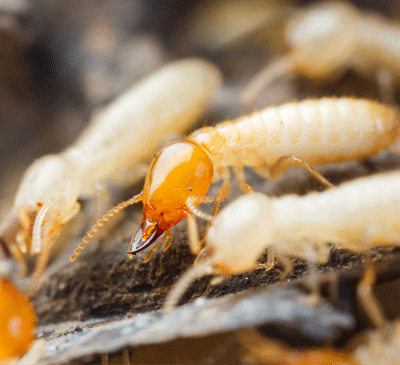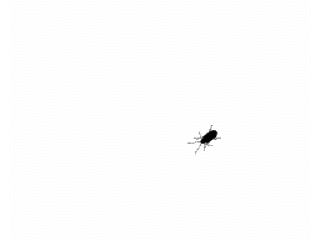
From $115
TERMITES PEST CONTROL PERTH
Like ants and some bees and wasps from the separate order Hymenoptera, termites divide labour among castes consisting of sterile male and female "workers" and "soldiers". All colonies have fertile males called "kings" and one or more fertile females called "queens". Termites mostly feed on dead plant material and cellulose, generally in the form of wood, leaf litter, soil, or animal dung. Termites are major detritivores, particularly in the subtropical and tropical regions, and their recycling of wood and plant matter is of considerable ecological importance.
Termites are among the most successful groups of insects on Earth, colonising most landmasses except for Antarctica. Their colonies range in size from a few hundred individuals to enormous societies with several million individuals. Termite queens have the longest lifespan of any insect in the world, with some queens living up to 50 years. Unlike ants, which undergo a complete metamorphosis, each individual termite goes through an incomplete metamorphosis that proceeds through egg, nymph, and adult stages. Colonies are described as superorganisms because the termites form part of a self-regulating entity: the colony itself.
Termite Control Perth
Termites or white ants are a dreaded concept to most of us. A home is the biggest investment that most people make in their lifetime. When a homeowner has a chronic problem with termite (white ants) infestations, they usually wonder how it started in the first place. Termites require two things to survive: food and water. When they decide to move in, it's because they have access to wood or cellulose products and/or water. Many homes in Australia are "pre-treated" for termites. This means that a pest controller has created either a physical termite barrier which is located around penetrations through the concrete slabs and in the cavity of your house walls or a chemical termiticide barrier between the soil and the concrete foundation of your home. The termiticides used in pre-treatments usually don't always kill termites but in ideal situations they will impede and discourage termites from entering your home through the foundations.
Damage
Termites can cause damage that is often expensive to repair. It should be noted that termite damage is not covered by your home insurance and infestations can often be difficult to detect before the damage is done. A termites role is to recycle dead or decaying wood and this makes the structural timber in your property (being dead!) a target.
Worker termites tunnel up to 100m from their nest sites in search of timber. When foraging, if they come across any cracks or crevices in your property foundations, they will use this to access the timber structure food source.
Termite Prevention
Inspections
The Australian standard AS3660 (protection of buildings from subterranean termites) provides details for minimising the risks to buildings from termite attack, and methods for treatment to control termite infestations. The provision of a complete termite barrier will impede and discourage termite entry into buildings, however it cannot prevent termite attacks. Termites can still bridge, or breach barriers but they can be detected more readily during routine inspections. Regular inspections are a vital part of termite control. An annual inspection will allow early detection of termites and identify any conditions that are conducive to termites in and around your home.
Pests Out WA will provide you with a full report in accordance with Australian standards, informing you of any conditions that are conducive to termite activity and provide information on general preventative methods that you can employ. The following points are addressed within our reports;
- Termite activity
- Termite damage
- Timber Decay
- Wood Borers
- Chemical Delignification
- Current and/or previous termite management programs
- Conditions conductive to Timber Pest Attack
- Advice for ongoing Termite Management Programs
- Environmental factors in and around your property
- Timber Pest risk assessment & advice
- Hardwood timber retaining walls and fences
- Loose and/or stored timbers to the yards or sub-floor areas etc.
- Trees, shrubs
- 11 Page Report
For more information regarding inspections, please refer to our Inspections Page.
Treatments
There are several methods of general preventative treatments that we utilise to treat Termites including chemical barriers and termite baiting;
Barrier Treatments
A Pests Out WA chemical barrier termite treatment is undertaken in accordance with the latest Australian standards and codes of practice.
- A thorough timber pest inspection compliant to Australian standards is carried out on the property. This process of this inspection ensures that all conditions conducive to termites are identified along with potential ingress points
- Trenching and flooding around the external perimeter of the building is undertaken where soil meets concrete
- Where the perimeter is paved, ideally pavers will be lifted in advance to allow the trench and flooding. If this is not possible a drill and inject method will be utilised
- Where timber floors are present within the home, trenching and flooding around the internal perimeter of the subfloor including piers and stumps may be required
- Drill and inject all penetrations (typically plumbing penetrations) through the concrete slab, soil abutting the property and drill and inject around any cracks in concrete surfaces
Note: Although this treatment offers superb protection, limitations of this treatment include areas around water heaters and air conditioning units and occasionally pipework. These are areas where a continuous unbroken barrier might not be able to be installed. Other issues include the possibility that termites can enter the building via gaps, holes or cracks in the concrete slab under the building.
Chemicals - The Weapon of Choice
The chemicals available on the market generally fall into two categories, that being repellent or non-repellent (undetectable).
Termidor
Termidor is recognised as being a superior and one of the more effective chemical treatments available. The active ingredient, Fiprinol, has been registered in Australia since 1996. It is water based non-repellent termiticide and has no odour. Termidor has a residual life span of up to eight years.
Termites come into contact with Termidor at the edge of the treated zone as they tunnel through the soil. At this point the product is at its lowest concentration. Those Termites that do not immediately continue tunneling into the Termidor treated zone will survive long enough to transfer Termidor to others in the colony through normal feeding and grooming. If the termites continue to tunnel into the treated soil where Termidor concentration is higher, they will be neutralized quicker. Termidor has the ability through the transfer effect of chemical, to neutralise the Termite nest.
Maxthor (Bifenthrin)
Bifenthrin in a synthetic pythrethroid modelled on the natural pythrethrum daisy. Bifenthrin works by killing active termites and repelling termites away from treated areas. It is soluble in soil; this means that it will not be leached away by rainfall or watering. The active constituent has a low volatility. This means that one is not exposed to airborne residues after the treatment. Bifenthrin has a residual life of up 10 years. This chemical is a repellent of Termites, which means that it is unlikely to kill off any nearby termite nests. To this end termites may keep foraging for other ways of entering the property.
Prothor (Imidachloprid)
Prothor is applied as a continuous chemical soil zone around the building and supporting structures. Prothor is undetectable to termites and therefore they cannot avoid the barrier. Termites come into contact with Prothor at the edge of the treated zone as they tunnel through the soil. Once in contact with the chemical they are killed however the action is delayed in order that the termites may transfer the product onto other termites in the colony through normal feeding and grooming.
When applied according to label instructions Prothor has minimal impact on the environment as it is a schedule 5 rather than the usual 6 poison. The active ingredient is Imidocloprid, which is water-based when applied and has no odour. Prothor at 0.25% concentration has a life span of up to five years. This is a superior and more effective treatment to repellant chemical in that it kills foraging termites directly and well as causing a transfer or viral effect.
TERMITE BAITING TREATMENT
- Assessment of termite activity followed by advice to the customer in regard to reduction of conditions conducive to termites. This is followed by our site survey for the installation of the Exterra baiting system.
- The first step of using EXTERRA is to install In-ground Stations around your property where termites are likely to be foraging for food. The Stations contain eucalypt timber interceptors that numerous, independent, studies have shown are the termites preferred food source. If your property is surrounded by concrete, then the special EXTERRA In-concrete Station is used. This has a stainless steel cap that seals flush with the pathway.
- EXTERRA Above-ground Stations are the preferred approach when termites are already in your home. This allows your termite problem to be dealt with immediately, right at the point of termite attack. REQUIEM Termite Bait is placed in the safe and sealed Station when it is installed. Above-ground Stations speed up the process of colony elimination. After the termite colony is eliminated, the Above-ground Stations are removed.
- Pests Out WA will check your stations regularly. A hand-held computer and barcode scanner are used to ensure the quality of your program when the termites are intercepted.
- Termites are easily detected in the EXTERRA Stations. The unique (patented) design of the EXTERRA Station allows for termites to be seen without disturbing them. This is very important. Requiem Termite Bait is added without disturbing the termites. This is vital to achieve quick and consistent results. Requiem Termite Bait is highly palatable to termites and they readily consume it in preference to timber. In fact Australian studies show that once termites start feeding on Requiem, they stop feeding on timbers in your home! Requiem Termite Bait is also non-toxic to you and your pets.
- Termites can't resist REQUIEM, leading to the colony's quick demise. The termites feed on the REQUIEM and take it back to the colony where it is fed slowly throughout the entire colony. Since the termites die gradually, they do not associate the colony's demise with the consumption of REQUIEM. This ensures that the entire colony is eliminated.
- The colony is eliminated. Any remaining REQUIEM is removed. Fresh timber interceptors are placed in the In-ground Stations, and the Above-ground Stations are removed. To protect you against the constant threat from new termite colonies or other established colonies, the EXTERRA System works on an ongoing process of 'Peace of Mind' monitoring, baiting and eliminating



